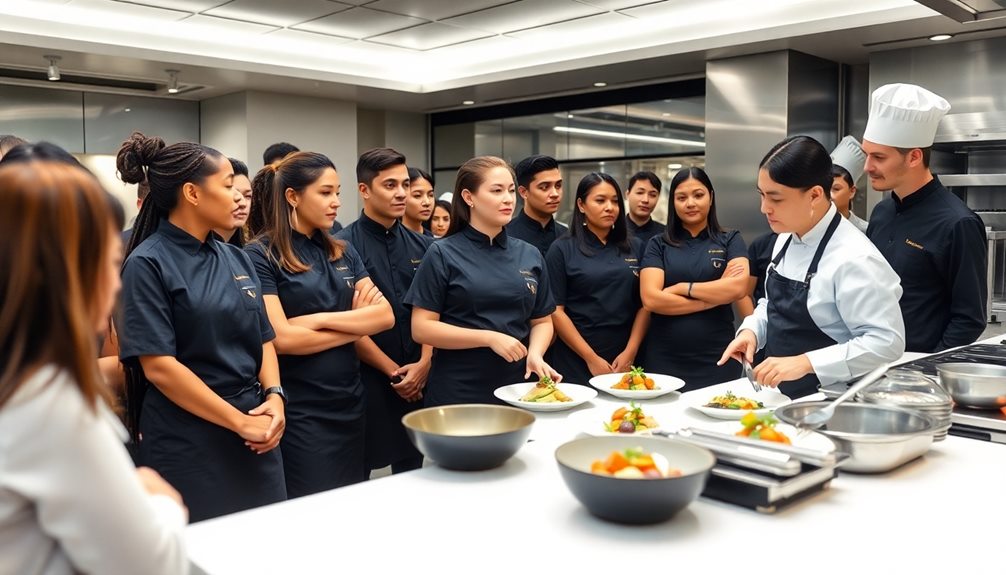Restaurants train new staff through structured onboarding processes that set clear expectations and equip you with essential tools. You'll typically start with introductions to the mission, values, and policies, followed by role-specific training. Hands-on experiences like shadowing and peer mentoring help build confidence and teamwork. Safety and compliance training are vital, ensuring you know food handling regulations and safe practices. Ongoing training keeps you informed of menu updates and industry trends. Regular feedback helps improve your skills and performance too. If you want to discover more about these training techniques, there are plenty of useful insights ahead.
Key Takeaways
- Structured onboarding processes introduce new hires to the restaurant's mission, values, and operational policies, enhancing their success from day one.
- Role-specific training ensures staff are well-prepared for their unique responsibilities and fosters confidence in their roles.
- Ongoing training sessions keep employees updated on menu items, industry trends, and compliance with food safety regulations.
- Engaging training methods, such as role-playing and gamification, improve retention and team collaboration among staff.
- Regular feedback and performance evaluations foster a culture of growth, helping identify strengths and areas for improvement.
Importance of Training and Onboarding
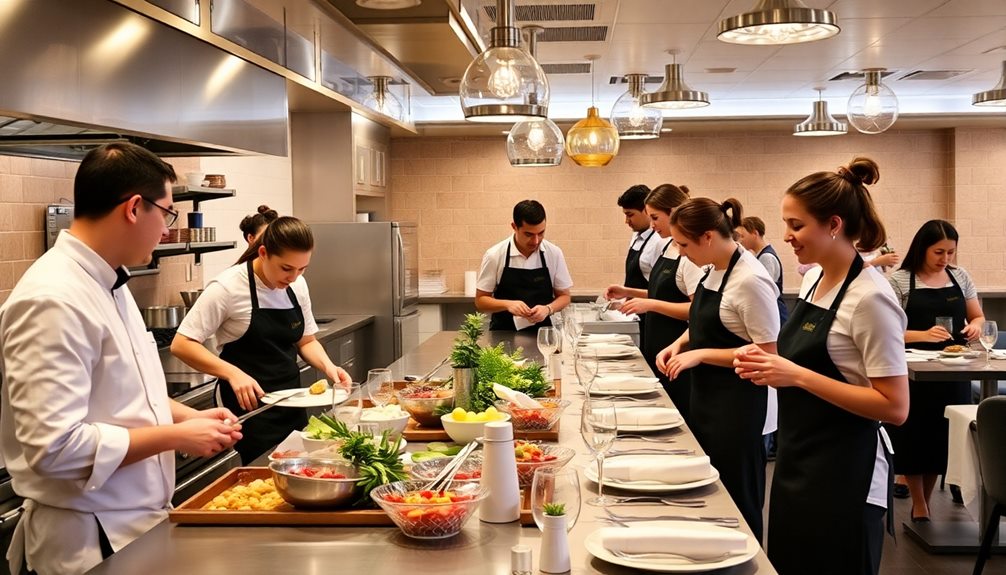
Training and onboarding are the backbone of a successful restaurant team. When you prioritize a structured onboarding process, you set new hires up for success from day one. This process includes essential paperwork and policy setup, which not only clarifies expectations but also enhances efficiency.
In the restaurant industry, where turnover rates can reach a staggering 75%, effective training is vital. In fact, 62% of employees cite inadequate training opportunities as a reason for leaving.
Comprehensive training goes beyond just the initial onboarding. It incorporates ongoing training that boosts employee confidence and loyalty, fostering an environment where staff feel valued and invested in their roles.
This includes customer service training tailored to your restaurant's style, which directly impacts the guest experience.
Employee Turnover and Retention

Employee turnover in the restaurant industry is alarmingly high, often reaching around 75%. Many employees see their roles as temporary, which can lead to a cycle of constant hiring and training.
To combat this, you need to focus on retention strategies that emphasize training opportunities. A significant 62% of restaurant employees cite a lack of training as a primary reason for leaving. By investing in thorough training programs, you can boost employee satisfaction and create a more skilled team.
These programs not only enhance job performance but also help reduce turnover rates. When employees feel competent and supported, their commitment to the job increases.
Implementing continuous feedback mechanisms enables you to tailor training initiatives, fostering a culture of growth and loyalty. Employees who receive consistent feedback feel valued and are more likely to stay with your restaurant long-term.
In a competitive labor market, prioritizing employee satisfaction through effective training and development is essential. By focusing on these areas, you can create a work environment where employees are dedicated and motivated, ultimately leading to higher retention rates and a more stable workforce.
Types of Staff Training

To foster a stable workforce and improve retention, restaurants must implement various types of staff training that cater to different needs. This thorough approach guarantees that all employees are equipped with the skills and knowledge required to excel in their roles. Effective training programs should address both technical skills, such as food preparation and service etiquette, and soft skills, like communication and conflict resolution. Additionally, integrating training on efficient restaurant staff scheduling methods can help employees better manage their time while ensuring shifts are adequately covered. This holistic strategy not only enhances job satisfaction but also contributes to a more productive and harmonious work environment.
Here are four key types of training you can expect:
- New Hire Training: This initial orientation introduces you to the restaurant's mission, values, and operational policies, setting clear expectations for your role.
- Food Safety Training: Mandatory for all staff, this training equips you with essential knowledge about allergens, safe serving practices, and compliance with FDA guidelines.
- Role-Specific Training: Tailored to your unique responsibilities, this training focuses on enhancing your effectiveness in your specific role, whether you're a server, cook, or bartender.
- Ongoing Training Programs: These programs keep you updated on new menu items, service techniques, and industry trends, contributing to your professional development.
In addition to these, peer-to-peer mentoring and hands-on shadowing provide practical guidance, fostering team cohesion and confidence among new staff members throughout the training process.
Effective Training Strategies
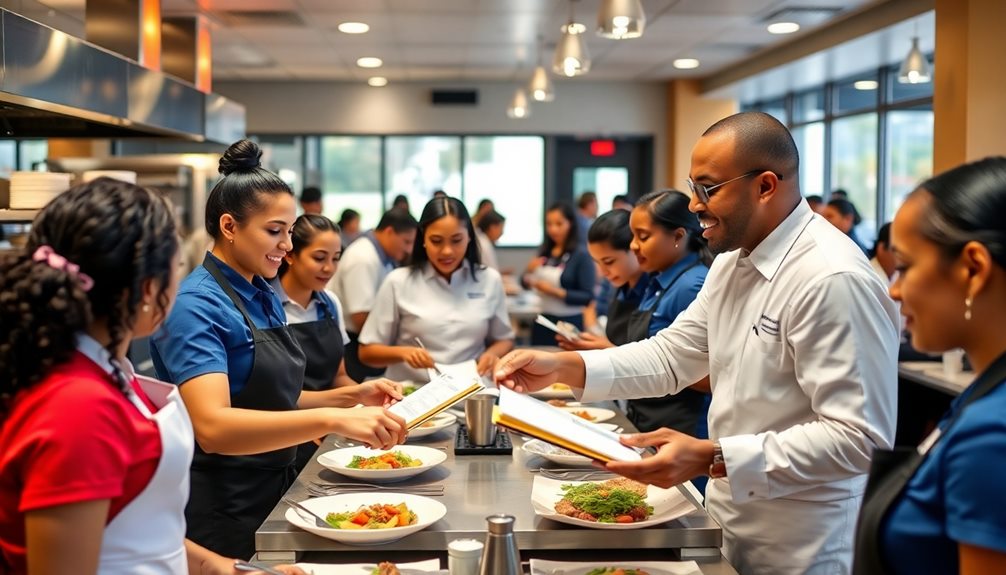
When you step into a restaurant, effective training strategies play an important role in shaping your experience as a new staff member. Onboarding sessions help set clear expectations and provide you with the vital tools to succeed from day one. Continuous training programs are essential for keeping you updated on procedures and industry trends; nearly 70% of hospitality employees leave due to inadequate training opportunities.
Role-specific training guarantees you're well-prepared for your unique responsibilities, while engaging training techniques like role-playing and peer mentoring foster teamwork and improve skill retention. Utilizing technology, such as interactive online training modules, enhances training effectiveness and accommodates diverse learning styles among team members.
Here's a quick overview of effective training strategies:
| Strategy | Benefits | Examples |
|---|---|---|
| Onboarding Sessions | Sets clear expectations | Restaurant training manual |
| Continuous Training Programs | Updates staff on trends | Monthly workshops |
| Role-Specific Training | Tailors training to positions | Specific task training |
| Engaging Techniques | Improves retention and teamwork | Role-playing scenarios |
Compliance and Safety Training
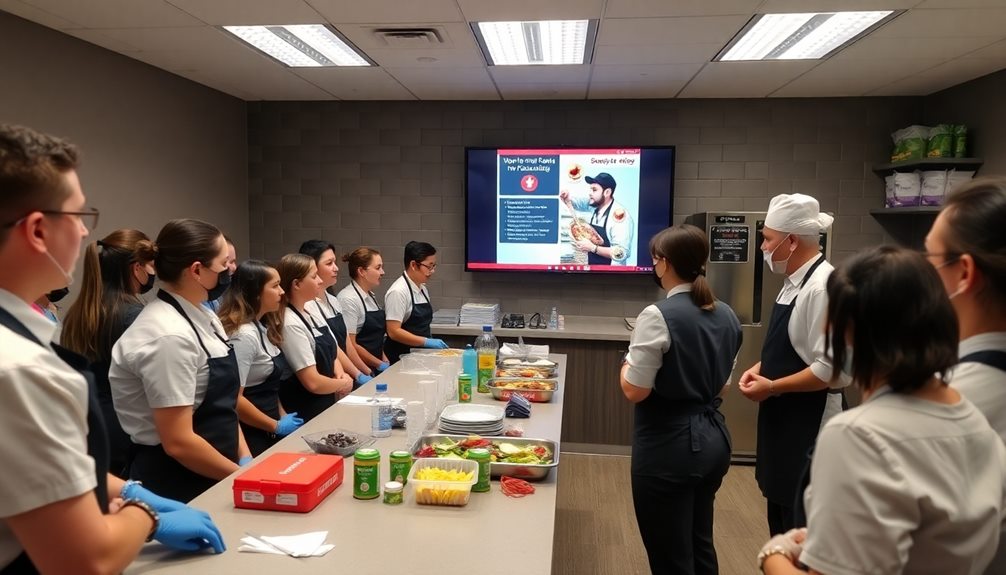
Effective training strategies lay the groundwork for a successful restaurant operation, but compliance and safety training take it a step further by guaranteeing both staff and customers are protected. This training is essential for maintaining high standards and avoiding potential liabilities.
Here's what you need to focus on:
- Compliance Training: Understand FDA Food Code regulations to guarantee safe food handling and prevent foodborne illnesses.
- OSHA Compliance Training: Learn about maintaining a safe, hazard-free work environment, which is critical to reducing workplace accidents.
- Workplace Harassment Training: Participate in mandatory education to foster an inclusive, discrimination-free environment, especially in light of the #MeToo movement.
- Food Safety Training: Obtain ServSafe certifications for employees handling food and alcohol, guaranteeing adherence to safety protocols and legal requirements.
Regular health inspections require ongoing training in safe food storage, cooking temperatures, and hygiene standards.
This commitment to compliance not only protects your restaurant but also enhances its reputation, guaranteeing a safe dining experience for customers and a secure working environment for staff.
Monitoring and Feedback
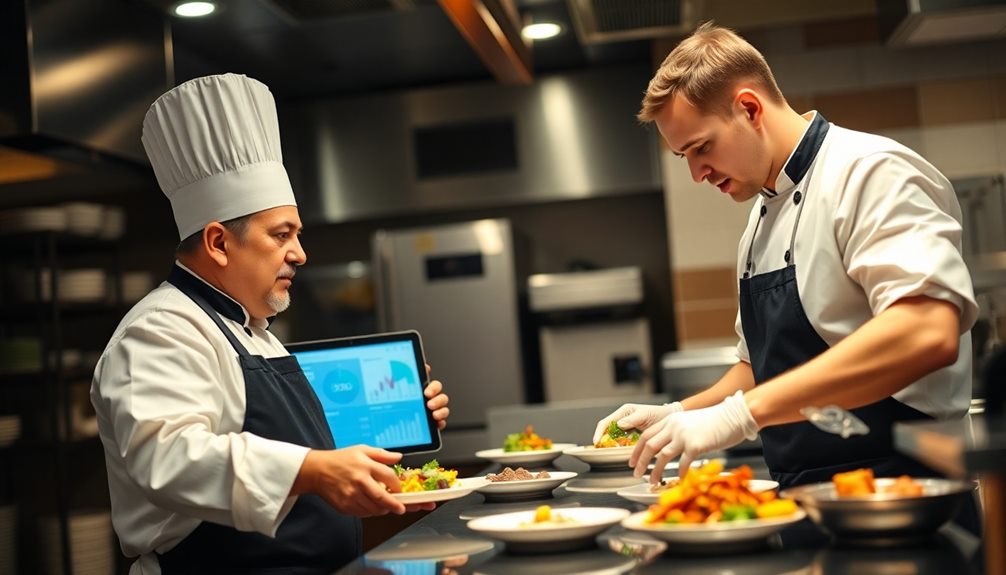
After training sessions, monitoring and feedback become essential for ensuring that new staff can apply what they've learned effectively. Regular monitoring of employee performance helps you assess the training's effectiveness and identify areas needing improvement.
Collecting feedback immediately after training provides valuable insights into the trainees' experiences, highlighting which aspects were beneficial or challenging. To encourage honest feedback, consider using anonymous surveys regarding training materials and delivery. This approach can reveal necessary adjustments to enhance future training sessions.
Utilizing performance metrics allows you to track new staff's progress against defined standards and expectations, ensuring they meet the restaurant's quality benchmarks. Conducting follow-up evaluations periodically after training sessions reinforces the skills learned and addresses any ongoing challenges your staff may face in their roles.
Role-Specific Training Approaches
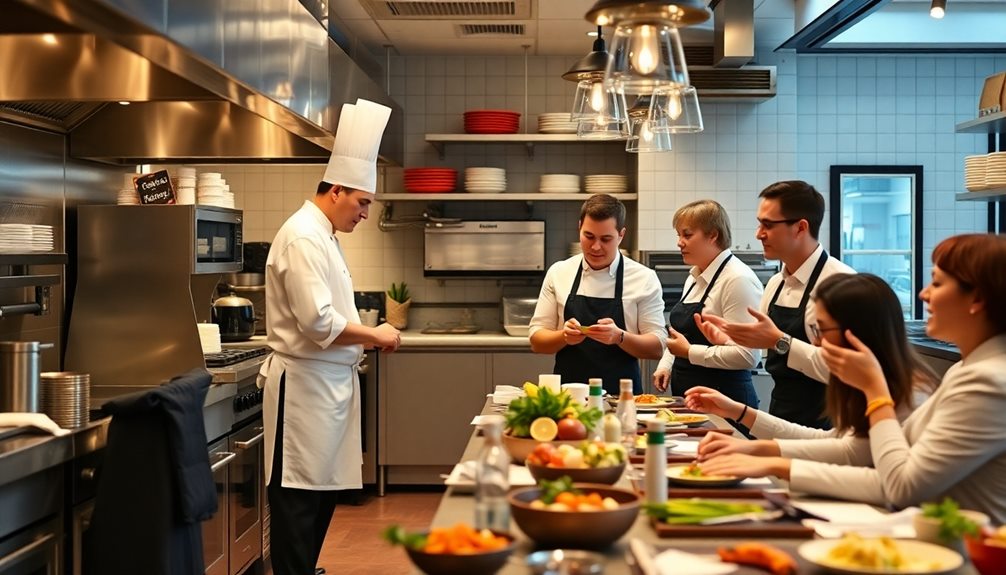
When it comes to role-specific training, you need programs tailored to your unique job function.
By focusing on practical skills and ongoing knowledge enhancement, you'll build confidence and improve your performance.
This approach not only equips you with essential skills but also guarantees you stay informed about best practices in your role.
Tailored Training Programs
While many restaurants implement general training for new staff, tailored training programs that focus on specific roles can considerably boost service quality and efficiency.
By developing role-specific training, you guarantee that new employees gain the crucial skills required for their positions. This approach not only enhances their confidence but also fosters competence in executing their duties.
Here are four key components of effective tailored training programs:
- Written Instructions: Provide clear guidelines on restaurant operations, allergen management, and food safety procedures.
- Training Binders: Equip staff with binders containing essential information like menu items, recipes, and contact details for quick reference.
- Practical Training Approaches: Implement education, demonstration, and shadowing to help new employees learn through hands-on experience.
- Training Videos and Infographics: Utilize these tools to accommodate diverse learning styles, making complex information more accessible.
Practical Skill Development
Effective practical skill development is essential for new staff in the restaurant industry. A robust restaurant training program is built on role-specific training that hones practical skills tailored to each job function. For kitchen staff, this may include mastering cooking techniques, while front-of-house employees focus on customer service protocols.
During the training process, you'll benefit from various methods, including education, demonstration, and shadowing. Observing experienced staff allows you to witness real scenarios and practice your skills under supervision.
To support your learning, training manuals should provide clear written instructions on operational information, including menu items and allergen management.
Essential aspects of role-specific training involve providing binders filled with critical operational information, such as opening and closing checklists and safety procedures. These resources empower you to perform your role confidently.
Additionally, ongoing training sessions keep you updated on new menu items and specials, ensuring you're well-prepared to engage customers effectively. This thorough approach to practical skill development not only enhances your capabilities but also contributes to the overall success of the restaurant.
Ongoing Knowledge Enhancement
Training doesn't stop after the initial onboarding process; ongoing knowledge enhancement is essential for maintaining high standards in the restaurant industry.
You need to focus on role-specific training that builds confidence and improves service quality. Here are some key components to reflect on in your training plan:
- Menu Items: Regularly review and update employees on new menu items, including ingredients and preparation methods.
- Customer Service Techniques: Conduct regular training sessions to refine customer service techniques, guaranteeing staff can handle various scenarios effectively.
- Technology: Keep your team proficient in using technology such as POS systems, providing hands-on training that integrates real-world applications.
- Continuous Learning: Implement a culture of continuous learning with practical experiences, like shadowing experienced staff, to enhance knowledge retention.
Incorporating these elements into your employee handbook and training materials guarantees that staff stay informed about safety protocols and allergen management.
Engaging Training Methods
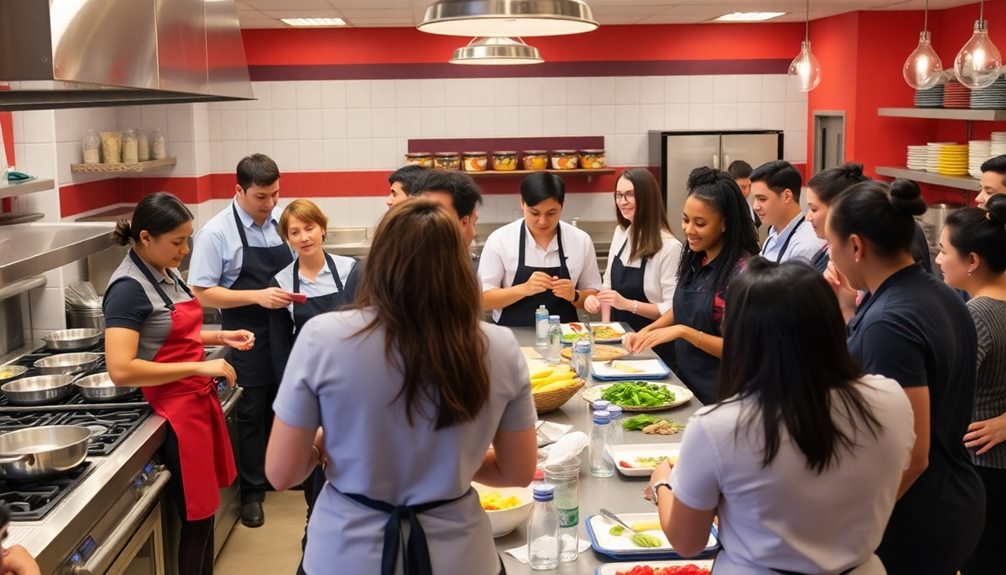
Engaging new staff in their training is essential for building confidence and service skills. You'll find that incorporating role-playing scenarios is a powerful way to practice customer interactions in a safe environment. This hands-on approach not only enhances your skills but also boosts your confidence.
Adding gamification to your training program can make learning fun and interactive, which keeps you motivated and helps you retain information more effectively. Peer-to-peer mentoring is another valuable method; by learning from seasoned staff, you benefit from their experience while fostering a collaborative learning atmosphere.
Utilizing video training resources allows you to learn at your own pace, giving you the flexibility to revisit complex topics as needed. This accommodates diverse learning styles within your team, ensuring everyone can grasp the necessary skills.
Lastly, regular feedback sessions after training are vital. They help identify your strengths and areas for improvement, ensuring the training methods stay effective and align with the restaurant's service standards.
Investing in Employee Development

Investing in employee development is key to fostering a motivated and loyal workforce.
By offering tailored training programs and promoting a culture of continuous learning, you not only boost job performance but also enhance employee satisfaction.
When your team sees clear growth opportunities, they're more likely to stay and contribute to the restaurant's success.
Importance of Growth Opportunities
One key to retaining top talent in the restaurant industry lies in offering growth opportunities through effective employee development programs. When you invest in training restaurant employees, you not only enhance their skills but also boost employee retention.
Nearly 70% of hospitality employees would leave due to inadequate training, making it essential to prioritize staff development. Additionally, fostering a supportive environment can lead to improved emotional well-being, much like the benefits seen in pet therapy for dementia and Parkinson's patients, where companionship and support play a fundamental role in enhancing overall morale the benefits of companionship.
Here are four ways to provide growth opportunities:
- Continuous Learning: Encourage employees to engage in ongoing training that enhances their skills and knowledge.
- Mentorship Programs: Pair new staff with experienced team members to foster a supportive environment and improve employee morale.
- Regular Feedback: Implement regular check-ins to discuss performance and areas for improvement, showing your commitment to their growth.
- Career Advancement: Promote from within whenever possible, creating a culture of upward mobility that motivates your team.
Tailored Training Programs
Effective training programs are tailored to meet the specific needs of each role within the restaurant. By focusing on role-specific skills, you can guarantee that new staff receive targeted instruction that enhances their confidence and job performance. Investing in employee development through these thorough training plans can greatly reduce turnover rates; about 62% of restaurant employees indicate they would leave due to a lack of training opportunities.
To create a motivating environment, consider incorporating methods like peer-to-peer mentoring and gamification within your training programs. These approaches not only boost employee satisfaction but also encourage retention. Additionally, implementing regular feedback mechanisms is essential. They help identify training interests and adjust content, making sure it meets the needs of new staff and aligns with service standards.
| Training Methods | Benefits |
|---|---|
| Peer-to-Peer Mentoring | Enhances collaboration and learning |
| Gamification | Increases engagement and motivation |
| Continuous Training | Adapts to industry changes |
Continuous Learning Culture
A strong continuous learning culture is essential in restaurants, as nearly 70% of hospitality employees would jump ship without proper training opportunities. Investing in employee development not only enhances skills but also promotes employee retention.
To foster this culture, consider the following effective training strategies:
- Regular training sessions: Schedule these every three to six months to keep your restaurant staff updated on best practices and industry trends.
- Engaging training methods: Utilize video resources, role-playing, and peer-to-peer mentoring to cater to diverse learning styles and maintain interest.
- Certifications: Encourage staff to pursue additional certifications. This not only boosts their competencies but also enhances morale, making them feel valued.
- Feedback mechanisms: Implement systems to gather feedback on training programs. This helps identify areas for improvement, ensuring that training remains relevant and effective.
Frequently Asked Questions
How to Train Employees in a Restaurant?
To train employees in a restaurant, you'll create a structured onboarding process, cover menu knowledge, utilize role-playing, and schedule ongoing training. Incorporating technology helps guarantee everyone learns effectively and stays up-to-date with procedures.
Which Method of Training Do Most Restaurants Use?
You'd think restaurants just toss new hires into the fryer, but most actually use a mix of orientation, hands-on training, peer mentoring, and video modules to guarantee everyone's ready for the fast-paced environment.
How Do You Train New Staff?
You train new staff by providing a structured onboarding process, covering essential topics and using interactive methods like role-playing. Regular feedback and assessments help build confidence and guarantee everyone stays updated on best practices and policies.
How Do Restaurants Recruit Employees?
Restaurants recruit employees by using job boards, social media, and local outreach. You'll see them at job fairs and culinary schools, offering competitive wages and career advancement opportunities to attract the right talent.
Conclusion
In the bustling world of restaurants, effective training transforms new hires into confident team players, ready to serve up smiles. Just like a chef perfecting a recipe, your investment in staff development creates a flavorful blend of skills and camaraderie. As you watch your team flourish, you'll see the vibrant colors of creativity and collaboration fill your establishment. Embrace the journey of training; it's the secret ingredient to a thriving restaurant that keeps customers coming back for more.
